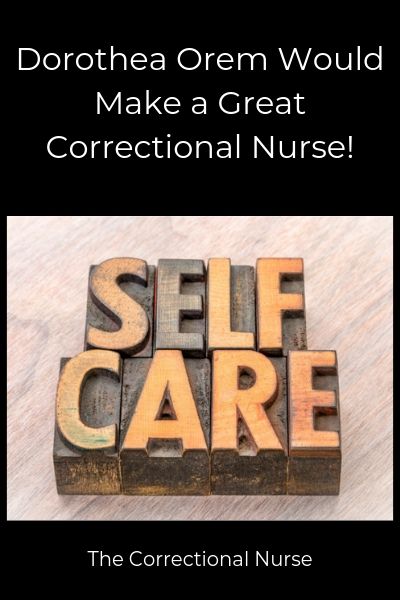Just having celebrated National Nurses Week, I am reminded of the many great nurses who helped build the nursing profession we have today. Nursing theorists are in this group of trailblazers. I must admit, I was mostly confused during my first go-round with nursing theories. Some of them are downright undecipherable (in my humble opinion!). However, Orem’s theory stood out as both practical and understandable. I came across her theory again in some reading I was doing for a writing project and was struck by how very applicable this nursing theory is to correctional nursing practice. Indeed, Dorothea Orem would make a great correctional nurse!

Self-Care at the Core
Orem’s theory of nursing targets self-care as the primary goal of nursing. After all, self-care and preservation is a human instinct. We naturally seek out adequate air, water, and food at the most basic of levels. Orem’s theory establishes self-care as initiating and performing actions that maintain life, health, and well-being.
Nursing is Meeting a Need
Nursing care is needed when illness, injury, or disease keeps an individual from meeting care needs independently. The condition may be too severe for self-care, such as a broken ankle. Or, the condition might be beyond the understanding or abilities of the individual, such as a complicated medication regimen for uncontrolled hypertension. Orem’s theory identifies five ways that nurses help patients with their self-care.
- Acting for and doing for others
- Guiding others
- Supporting another
- Providing an environment promoting personal development
- Teaching another
Nurses help patients in these five ways through three nursing systems.
- Wholly Compensatory: The nurse performs all self-care requirements and ‘compensates’ for the patient’s inability to perform these functions themselves. Patients in the infirmary may, at times, need wholly compensatory nursing care, as would patients in a man-down situation
- Partially Compensatory: The patient is able to provide some self-care but needs nursing assistance in other areas. This is the primary mode for nursing sick call, medication administration, and intake screening.
- Supportive-Education: Here the nurse supports and educates the patient to be able to maintain and enhance their self-care process. Sometimes this system is active in a nursing sick call situation where the condition does not require treatment as much as patient education. This might also be the system in operation when nurses provide general or group education to the patient population such as at intake or at health fairs.
Applying the Orem Theory to Correctional Nursing Practice
Orem’s theory is a practical way to apply nursing theory to correctional nursing practice. Here is an example of use in a common nursing sick call situation.
Inmate Drake, age 32, is 10 days into a 30 day stay in a county jail. He comes to nursing sick call having submitted a slip requesting something for constipation. He states he is usually quite regular but has not had a bowel movement for 5 days.
Nursing System: Partially Compensatory. This patient will likely need some help to regain a regular elimination pattern but should be able to return to self-care with support.
- After a review of systems and an abdominal assessment, the nurse provides an approved OTC medication for constipation.
- The nurse also asks about his exercise and eating patterns and provides guidance on how to increase fiber, fluid, and activity while incarcerated.
- She then instructs him on returning to sick call if these interventions are not successful.
So, this sick call nurse met the patient’s needs through several of Orem’s five nursing activities: doing for the patient, guiding, and teaching him about ways to self-care for bowel hygiene.
Although Orem’s theory is practical and easy to apply, critics of the framework say there isn’t enough attention to the emotional needs of the patient or the impact of the environment on the patient. The emotional and psychological health of incarcerated patients and the unique environment of care behind bars may need further attention than can be provided by applying this theory, but it is a good start.
So, what do you think? Would Dorothea Orem’s theory work in your setting? Share your thoughts in the comments section of this post.
Other posts that might interest you:
- Caring in Correctional Nursing: Research Review
- Four Ways to Build a Trust Relationship with Inmates
- Building a Trust Relationship with Inmates: Booby Traps
- I Found Correctional Nursing and I Love it!
[The information above was originally posted on the Essentials of Correctional Nursing blog]
Alexina White (RN) says
Dorothea Orem’s theory is the most practical way to serve the patients behind the bar, and correctional nurses are most suited for promoting self-care practice among prisoners.